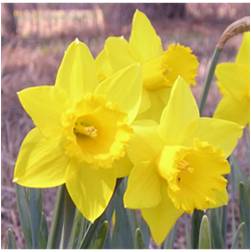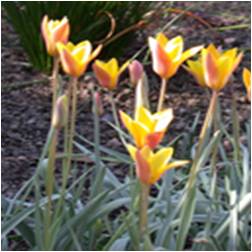Plant Bulbs for Spring Color!
go.ncsu.edu/readext?245765
en Español / em Português
El inglés es el idioma de control de esta página. En la medida en que haya algún conflicto entre la traducción al inglés y la traducción, el inglés prevalece.
Al hacer clic en el enlace de traducción se activa un servicio de traducción gratuito para convertir la página al español. Al igual que con cualquier traducción por Internet, la conversión no es sensible al contexto y puede que no traduzca el texto en su significado original. NC State Extension no garantiza la exactitud del texto traducido. Por favor, tenga en cuenta que algunas aplicaciones y/o servicios pueden no funcionar como se espera cuando se traducen.
Português
Inglês é o idioma de controle desta página. Na medida que haja algum conflito entre o texto original em Inglês e a tradução, o Inglês prevalece.
Ao clicar no link de tradução, um serviço gratuito de tradução será ativado para converter a página para o Português. Como em qualquer tradução pela internet, a conversão não é sensivel ao contexto e pode não ocorrer a tradução para o significado orginal. O serviço de Extensão da Carolina do Norte (NC State Extension) não garante a exatidão do texto traduzido. Por favor, observe que algumas funções ou serviços podem não funcionar como esperado após a tradução.
English
English is the controlling language of this page. To the extent there is any conflict between the English text and the translation, English controls.
Clicking on the translation link activates a free translation service to convert the page to Spanish. As with any Internet translation, the conversion is not context-sensitive and may not translate the text to its original meaning. NC State Extension does not guarantee the accuracy of the translated text. Please note that some applications and/or services may not function as expected when translated.
Collapse ▲
‘St. Keverne’ is one of the best daffodils for southern landscapes.
Spring blooming bulbs are some of our earliest flowering perennials, bursting into bloom at a time most of us are desperate to see colors other than brown and gray. While late fall (mid-November through mid-December) is the best time to plant spring blooming bulbs in our region, early fall is the time to order or purchase them, but not all varieties are equally long lived. Make the most of your bulb planting experience by seeking out these reliably perennial varieties.
Recommended Varieties
Daffodils are among the most well-known of spring bloomers, but not all types are equally reliable in our region. If you are looking for a classic large flowered yellow daffodil that will return and multiply for years to come, plant ‘St.Keverne’, one of the best all-around performers for southern landscapes. For a splash of color very early in the season, try ‘Jack Snipe’, a low growing, bicolor yellow and white variety that blooms in February.
Also dependable are the varieties sometimes referred to as jonquils, known for their exceptionally fragrant blossoms. One of my favorites is ‘Quail’, which bears multiple golden yellow blossoms on each stem. Other great daffodils for fragrance and reliability include ‘Minnow’, a low growing variety with white and yellow blossoms, and ‘Cheerfulness’, a hardy paperwhite type with double white flowers.
More reliably perennial spring blooming bulbs for our climate include Spanish bluebells (Hyacinthoides hispanica), with spikes of blue blossoms that open the same time as azaleas; summer snowflake (Leucojum aestivum), whose dainty spikes of white bell shaped flowers resemble lily of the valley and open in April; and starflower (Ipheon uniflorum), a low growing, early bloomer with icy blue, star shaped blossoms. In addition to being perennial, these bulb varieties, along with daffodils, are rarely bothered by deer or rabbits.
If you have gardened in the south for more than a couple of seasons you have probably already discovered large flowered hybrid tulips are not perennial here. But have you ever tried the smaller flowered species tulips? One of the best for our region is the lady tulip, Tulipa clusiana ‘Cynthia’. This early blooming, ten inch tall tulip bears dainty yellow and rose-red blossoms in late March and has returned to bloom and multiply in my garden for several years now.
For color beyond spring, add lilies to your landscape. Two reliable types for our region are Asiatic lilies and oriental lilies. Asiatic lilies tend to be a shorter and bloom slightly earlier than oriental lilies, in May and June, with blossoms in bright shades of orange, yellow, white, pink, and red. Oriental lilies are what most people think of when they picture a lily. ‘Stargazer’ is one of the most popular varieties, bearing large, fragrant, raspberry red blossoms on three foot tall stems in June and July. Both types thrive in sun to part shade and well drained soil, but are a favorite of deer so plant them close to your home or in a fenced area.
Using Bulbs In the Landscape
For high impact, plant bulbs in solid masses or large sweeps. To add color and interest to existing beds and borders, tuck bulbs between perennials and deciduous shrubs, where they will bring early color to otherwise dormant areas. Bulbs also work well when planted beneath winter annuals such as pansies and violas, creating a layered effect when they come up to bloom in spring.
Bulbs perennialize best in sunny areas or under deciduous trees. All bulbs prefer to grow in well drained soil, except summer snowflake, which grows quite happily in heavy, moist soil. A general rule of thumb for planting bulbs is to set them at a depth two to three times the size of the bulb; This means small bulbs are only planted 3” to 4” deep, while larger bulbs like daffodils are planted at a depth of 8”. A slow release or organic fertilizer can be worked into the soil at planting time or applied in spring when bulb foliage begins to emerge.
Visit your local Cooperative Extension office to learn more about gardening and landscape care. Go to https://www.ces.ncsu.edu/local-county-center/ to find your county Extension center.
- If you live in Pender County, call 910-259-1235
- In New Hanover County, call 910-798-7660
- In Brunswick County, call 910-253-2610
- In Onslow County, call 910-455-5873
- In Duplin County, call 910-296-2143




